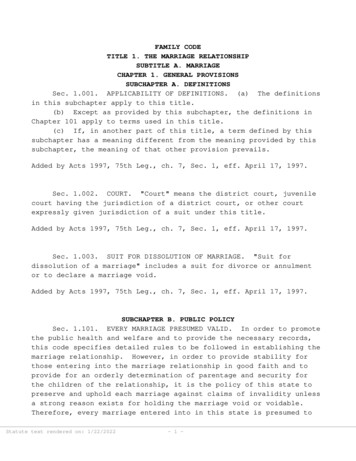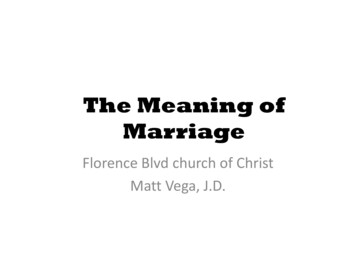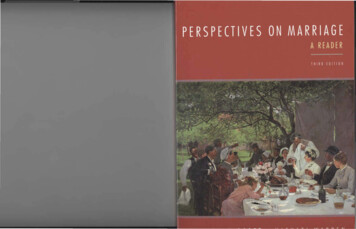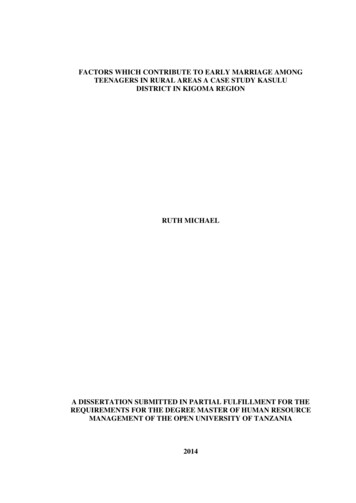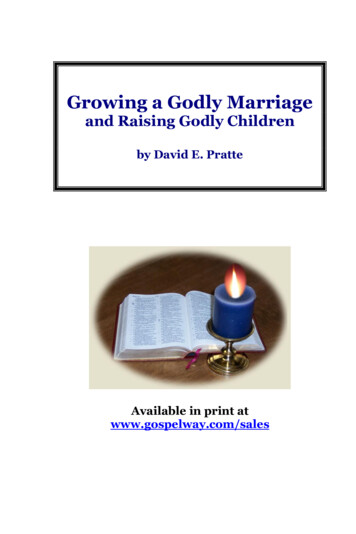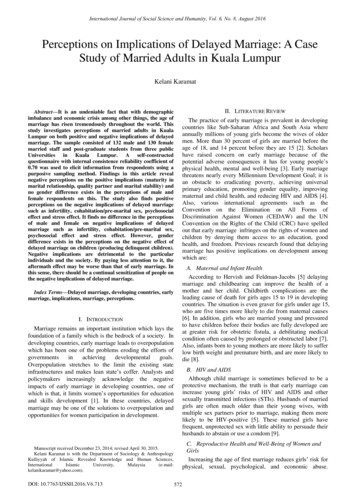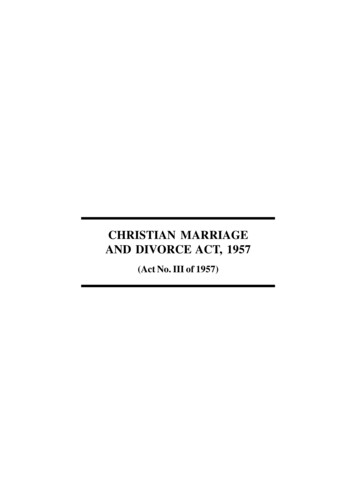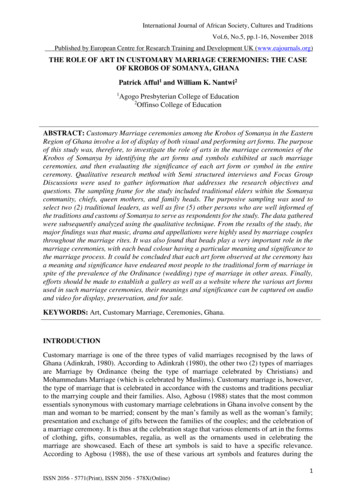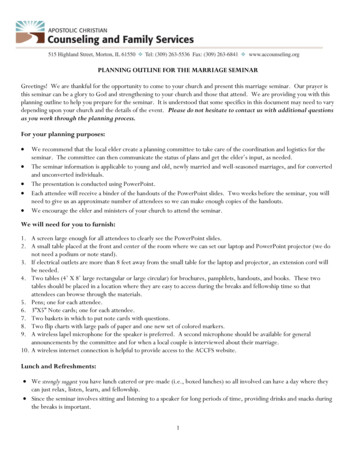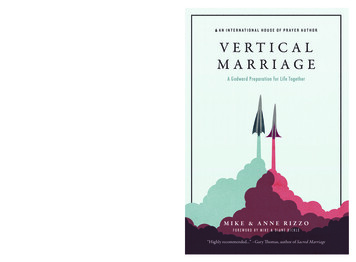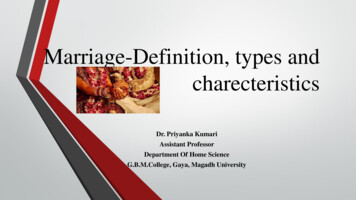
Transcription
Marriage-Definition, types andcharecteristicsDr. Priyanka KumariAssistant ProfessorDepartment Of Home ScienceG.B.M.College, Gaya, Magadh University.
Contents Definitions Types Characteristics References
Definition Marriage is one of the universal social institutions established to control and regulate the life of mankind. It is closely associated with the institution offamily.Infact both the institutions are complementary to each other. It is an institutionwith different implications in different cultures.As an institution marriage is designed to satisfy the biological needsespecially the sexual needs of the individual in a legal, customary, culturallydefined and socially approved man Unilateral descent rule Cognative nonunlineal
Definition by different sociologist WestermarckIn his book 'History of Human marriage' defines marriage as the more or less durableconnection between male and female lasting beyond the mere act of propagation till afterthe birth of offspring. Malinowski marriage is a contract for the production and maintenance of children. Robert Lowie Hedescribes marriage as a relatively permanent bond between permissiblemates. Hoebel The complexes of social norms that define and Control the relations of a matedpair to each other their kinsmen, their offspring and their society at large. Horton and Hunt Heexplained marriage is the approved social pattern whereby two or more
Types of marriage As a universal social institution marriage is found to exist in all societies andat all stages of development. Types or forms of marriage varies from societyto society. Types or forms of marriage in different communities, societies andcultural groups differ according to their customs, practices and systems ofthought.
Types of Marriage On the basis of number of mates On the basis of number of mates marriage may be classified into three types such asMonogamy, Polygamy and Endogamy or group marriage
Continued On the basis of choice of mate or on the basis of rules of mate selection Marriage may be divided into two types i.e. endogamous and exogamous marriages on thebasis of choice of mate or on the basis of the rules of choice of mate. Endogamy is dividedinto four sub types such as caste, sub-caste, varna and tribal endogamy. Similarly exogamousmarriage may be divided into four sub-types such as Gotra, Pravar, Sapinda and villageexogamy
Continued . Sapinda exogamy Sapinda means-lineage. People belonging to five generations from father sideand three or seven generation from mother side are known as sapindas. Theybelieved to belong a particular pinda. Hence according to sapinda exogamymarriage within one’s own sapinda is forbidden. They are supposed to marryoutside one’s own sapnida.Village exogamy According to this principle marriage within one’s own village is forbidden eachand every society prescribes certain rules relating to marriage. Some societiesput several restrictions on marriage among kins whereas some other societiesallows marriage between a limited number of kin.
Village exogamy Hence in those societies marriage is sanctioned on the basis of preference or priority Cross-cousin marriage: When marriage takes place between one’s mother’s brother’s daughter/son with father’s sister’s son/daughter wecalled it as cross cousin marriage. The marriage of Abhimanyu with Sashikala is an example of this cross-cousin typeof marriage. This type of marriage supposed to be practised in some part of Orissa, Rajasthan, and Maharashtra etc.This type of marriage occur to avoid payment of high bride price and to maintain one’s family property. Parallel Cousin marriage: When marriage takes place between the children of either two sisters or two brothers it is known as parallel cousinmarriage. This type of marriage is mostly found among Muslims. Levirate: It is otherwise known as ‘Devar Vivaha’. When a woman marries her husband’s brother after the death of herhusband it is known as levirate. This type of marriage is found among some tribes like the Gond, the Munda or theSantal the oran and the Toda etc Sororate: It is otherwise known as ‘Sali Vivah’. When a man marries his wife’s sister after the death of his wife or even whenthe wife is alive it is called as sororate. This type of marriage is found among some tribes like the Kharia and theGond.
Continued . Anuloma or Pratiloma Anuloma marriage or Hypergamy: When a man of higher caste or varna marries a woman of lower caste or varna it is called asAnuloma or Hypergamy marriage. In traditional Indian society hypergamy is known as Anuloma.This was in practice among the nobles in the past. In Bengal it was found in the form of Kulinism.Pratiloma marriage or Hypogamy: Pratiloma or hypogamy marriage is just opposite of Anuloma or hypergamy. When a man oflower caste or status marries a woman of higher caste or status it is known as pratiloma orhypogamy marriage. This is not an approved form of marriage
Characteristics of Marriage Marriage is a universal social institution. It is found in almost all societiesand at all stages of development. Marriage is a permanent bond between husband and wife. It is designedto fulfill the social, psychological, biological and religious aims. Marriage is a specific relationship between two individuals of oppositesex and based on mutual rights and obligations. Relationship is enduring. Marriage requires social approval. The relationship between men andwomen must have social approval. Without which marriage is not valid. Marriage establishes family. Family helps in providing facilities for theprocreation and upbringing of children.
Continued . Marriage creates mutual obligations between husband and wife. The couple fulfill theirmutual obligations on the basis of customs or rules. Marriage is always associated with some civil and religious ceremony. This social andreligious ceremony provides validity to marriage. Though modern marriage performed incourts still it requires certain religious or customary practices. Marriage regulates sex relationship according to prescribed customs and laws. Marriage has certain symbols like ring, vermillion, special cloths, special sign before thehouse etc.
References and Books Haris C. C., The Sociology Enterprises: A Disscussion of Fundamental Concept, St. MartinPress Inc., New York, 1980 Williams, Malcom, Science and Social Science: An Introduction, Routledge, London, 2000 Haris C. C., The Sociology Enterprises: A Disscussion of Fundamental Concept, St. MartinPress Inc., New York, Ram Ahuja : Society in India Sociology: An introduction and analysis - Maciver and Page Source of Image: Google image
This type of marriage occur to avoid payment of high bride price and to maintain one's family property. Parallel Cousin marriage: When marriage takes place between the children of either two sisters or two brothers it is known as parallel cousin marriage. This type of marriage is mostly found among Muslims. Levirate:
